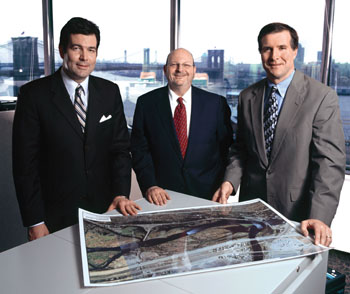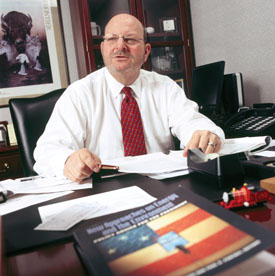
AIG Environmental executives (from left): John O’Brien, Executive Vice President; Joseph Boren, Chairman/CEO; and Peter Gilbertson, Director of Marketing.
Pollution coverage
market matures, broadens
AIG Environmental offers streamlined protection
By Phil Zinkewicz
 |
AIG Environmental executives (from left): John O’Brien, Executive Vice President; Joseph Boren, Chairman/CEO; and Peter Gilbertson, Director of Marketing. |
Last December, a freighter called the Selendang Ayu, carrying soybeans, 424,000 gallons of heavy bunker fuel and 18,000 gallons of diesel, lost power in the Aleutian chain, drifted powerless for two days and then ran aground about 800 miles from Anchorage. The freighter broke in two, rupturing a tank that held 40,131 gallons of fuel and creating a spill that eventually washed onto shore and into wildlife habitats that support sea lions, harbor seals, sea otters and tanner crabs. It is not known yet how long the cleanup of this event will take.
When we think of pollution exposures, we usually think of incidents like this: a ship running aground and causing millions of dollars worth of damage to the waters, wildlife and lands located around the spill. Exxon-Valdez immediately comes to mind. On-land pollution exposures conjure up scenes from the catastrophe at Love Canal.
It’s interesting to note, however, that in 2003 the National Research Council (NRC) did an assessment of oil spills over recent years. The NRC found that of human-released oil reaching marine waters around North America, 56% was runoff from land—the drips from vehicles and machinery, roads, parking lots and industrial sites. Spills from large ships, whether tankers or freighters, have been around 10%. In other words, the ecological impacts of chronic, low-level exposure to petroleum have not really been understood by consumers, businesses and even some insurance companies.
One insurer that does understand low-level exposures is AIG Environmental, a unit of American International Group. This year AIG Environmental is celebrating its 25th anniversary in the pollution insurance business. “There are always signature events that bring attention to a particular problem that has gone overlooked,” says Joseph Boren, chairman and CEO of AIG Environmental. “Exxon-Valdez was certainly a signature event in the area of pollution exposures.
“And Love Canal became the poster child for land pollution. Around Niagara Falls, there was a company called Hooker Chemical,” Boren continues. “They had been putting chemical waste into a ditch, originally intended to be a canal started by a man named Love, hence the name Love Canal. In 1994, they deeded the land to the Board of Education but told the board not to build anything on it because of the waste that had been buried there. But the Board of Education built on the property anyway—a school and housing around that school. Soon the waste started to seep into the school and the houses, and the government had to buy everybody out.
“There was a similar situation in Times Beach, Missouri,” says Boren. “There, it was common practice to take dirt streets and oil the roads to keep the dirt down. They used old oil from engines, which contained dioxin, a dangerous substance, and spread the oil all over the streets. This resulted in another evacuation.”
 |
“Today it has become obvious that companies that you would never imagine having pollution exposures actually do.” —Joseph Boren |
But, according to Boren, Congress had begun looking at the pollution problem in the 1970s. In 1976 Congress passed the landmark Resource Conservation and Recovery Act (RCRA). This law mandated a cradle-to-grave manifest-based tracking system for environmentally sensitive materials, which is still used today, and it also mandated financial responsibility for certain environmental businesses. This financial responsibility could be met through bonds, insurance or other mechanisms, and actually triggered the beginning of the environmental insurance industry. According to Boren, AIG was the first insurer in the industry to develop a pollution insurance product as part of the RCRA mandate. At the same time, the country’s growing asbestos litigation gathered strength and became an enormous liability crisis. Then in the wake of the 1980 Superfund law (CERCLA), businesses found themselves experiencing mixes of joint and several liability and strict liability for previously unheard of types of pollution exposures.
Pollution risk grows
“We started out small in the hazardous waste treatment, transport and disposal arena,” says Boren, “but over the last 25 years, we have become very big in the pollution insurance business. In 1980, government was looking closely at chemical companies in terms of pollution exposure. But as time went on, it became clear that there were other industries that had pollution liability. Today, 25 years later, it has become obvious that companies that you would never imagine having pollution exposures actually do. Even certain media companies have substantial environmental liabilities, often in connection with past acquisitions. Consider Silicon Valley. How do you make a computer chip without using chemicals?
“Furthermore,” continues Boren, “Superfund liability goes back to time immemorial. You can’t argue that you buried waste in a ditch back in the 1940s when no one knew of the dangers. Superfund says you’re liable. Even if you had a permit from the government to put the waste there, you are still liable.”
Therefore, says Boren, companies that have heretofore not had to deal with pollution risks are doing so now in a big way. “Twenty-five years ago, companies didn’t have environmental specialists and environmental lawyers on their staffs. Today many do. Love Canal was the signature event that changed corporate behavior throughout this country, in terms of how we deal with environmental liability issues. Now companies must consider where their pollution exposures are and where insurance comes in. And it’s not just large companies that have become affected,” says Boren. “Smaller firms are being affected as well. Take the mold situation. Today, whenever there is a mold situation, among those frequently brought into lawsuits are the heating, ventilation and air-conditioning (HVAC) contractors. Many of these are small, independent businesses that, before mold became an issue, didn’t even know they had an environmental exposure. They do now.”
Expanded coverage
For the last 25 years, Boren says, AIG Environmental’s growth has paralleled changing developments in the pollution arena. For that reason, the company recently expanded its Environmental and General Liability Exposures (EAGLE) program. The product portfolio features new coverage to provide a wider range of commercial enterprises with a broad environmental risk management program.
In addition to general liability, EAGLE now offers coverage for bodily injury and property damage arising from “sudden and accidental pollution events” as standard coverage under the policy, with minimal pollution underwriting. Comprehensive site pollution and product recall coverages remain available on an optional basis. Boren says that AIG member companies can provide related workers compensation and commercial property coverages for purchasers of the EAGLE program. Limits up to $10 million are available.
“Many commercial enterprises that readily purchase general liability insurance have shied away from environmental coverage because of the perceived high cost, a tedious application process and the view that perhaps their exposure to an environmental risk was not significant enough to warrant coverage,” says Boren. “But that perception has changed. Manufacturers, distributors and even industries that traditionally have not been pollution-generating sectors have come to realize the potential impact an environmental liability can have on their business. Our new program has been designed with the insurance needs of a broad array of sectors in mind, and with the ‘one carrier, one underwriter, one policy’ structure, we are offering a streamlined method to secure comprehensive combined casualty and environmental coverage. We have expanded the program to include a significant increase in the number of target industry classes, which include wholesale distributors, processors and manufacturers of products ranging from adhesive/caulking, asphalt, cement, fertilizer, food additives, and plastic and rubber goods to interior building materials, paint, storage tanks, industrial cleaners and cosmetics.”
Peter Gilbertson, director of marketing for AIG Environmental, says that independent agents and brokers are key to selling this expanded product. “I was a broker myself for10 years,” he says, “and I know that there are very few agents who focus on environmental coverages for their clients. There is a certain reticence on the part of many generalist agents and brokers, a fear of the complexity of the arena. With EAGLE, our intention has been to demystify the product and the process of insuring environmental risk. All the producer has to do is answer a few simple questions beyond the standard general liability application.”
Adds Boren: “The new EAGLE policy provides insureds with a single, cost-effective insurance program that helps eliminate the added costs and potential for errors and omissions that may result from having multiple policies in place from multiple insurers and underwriters. That’s the message we are trying to get out to agents and brokers, so that they can inform their clients of the product’s importance.” *
For more information
AIG Environmental
Web site: www.aigenvironmental.com